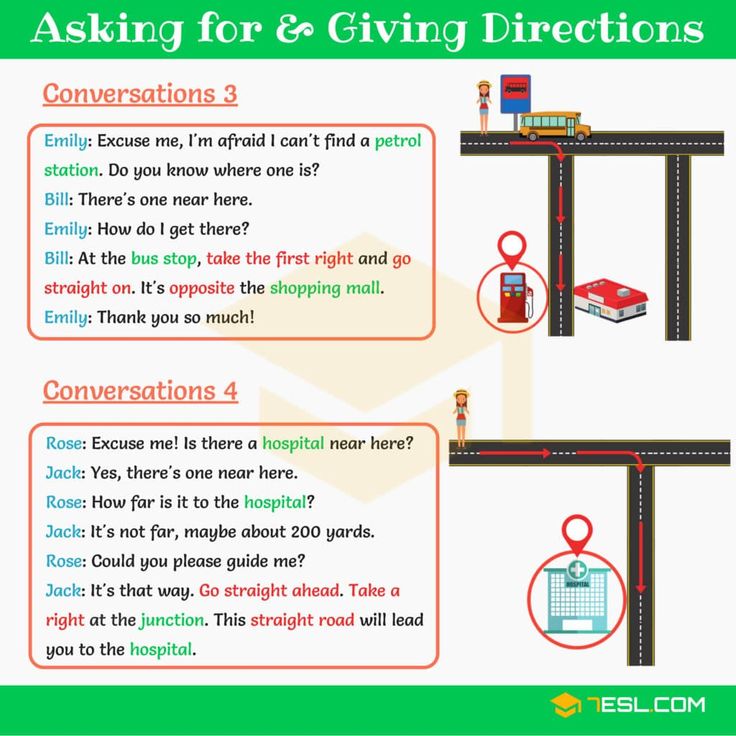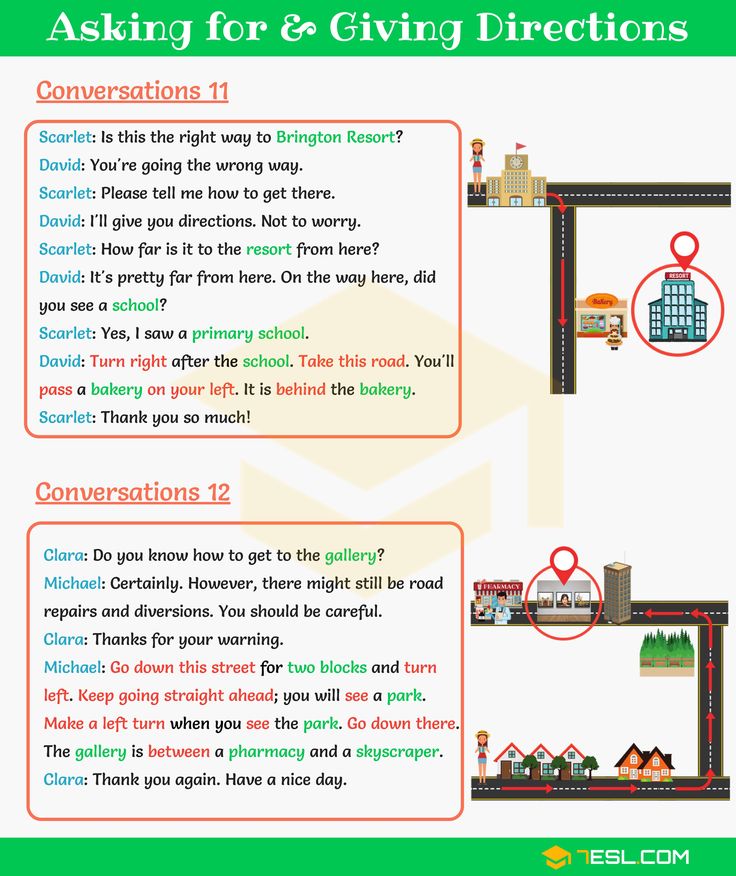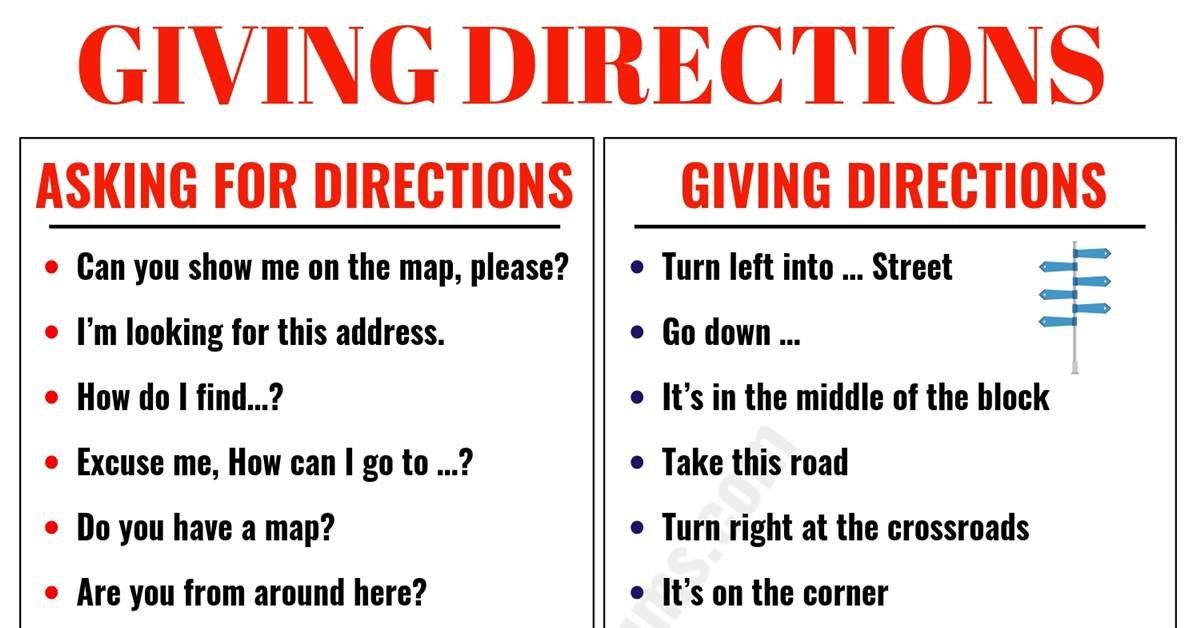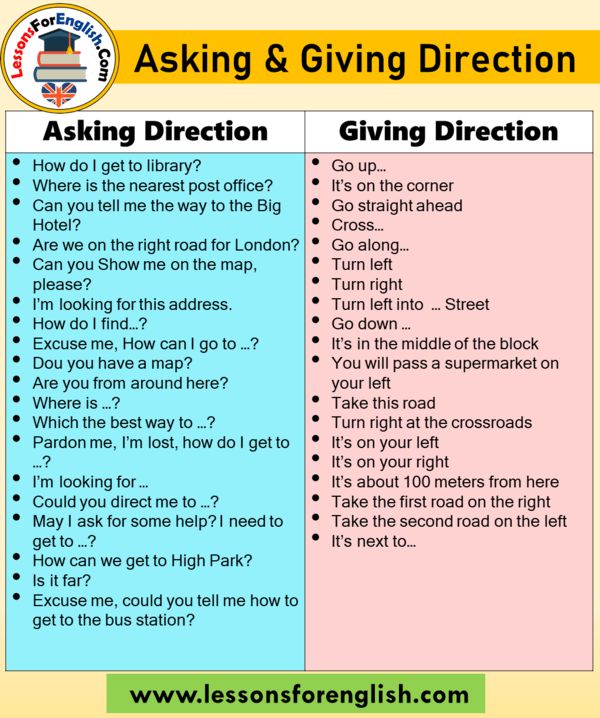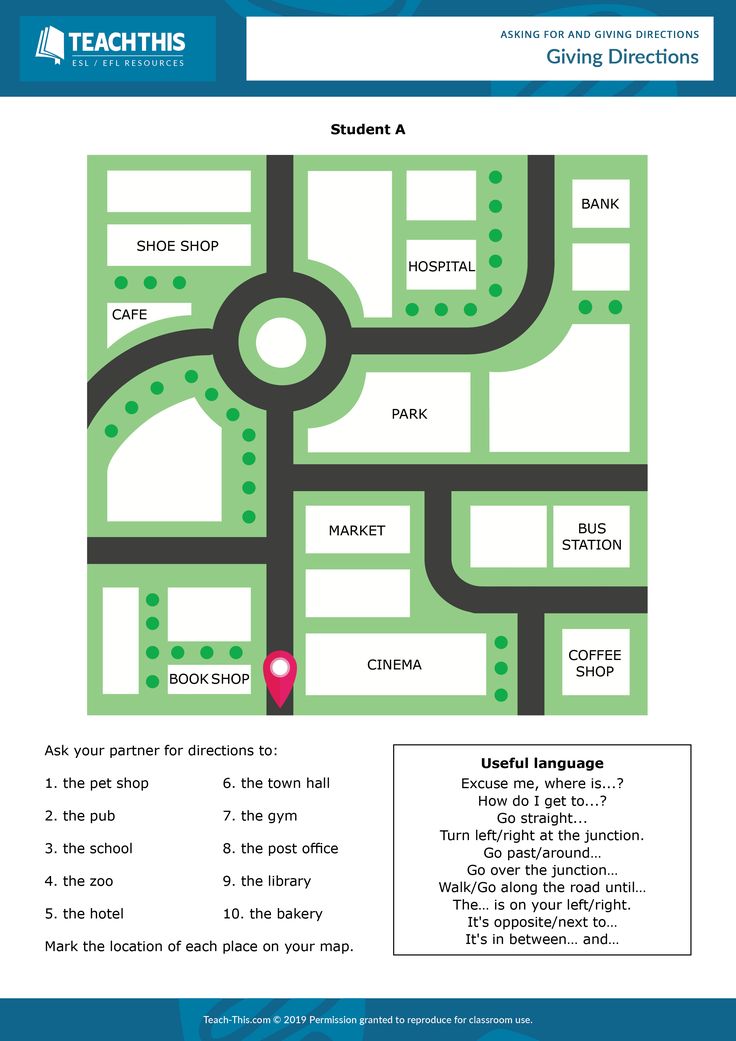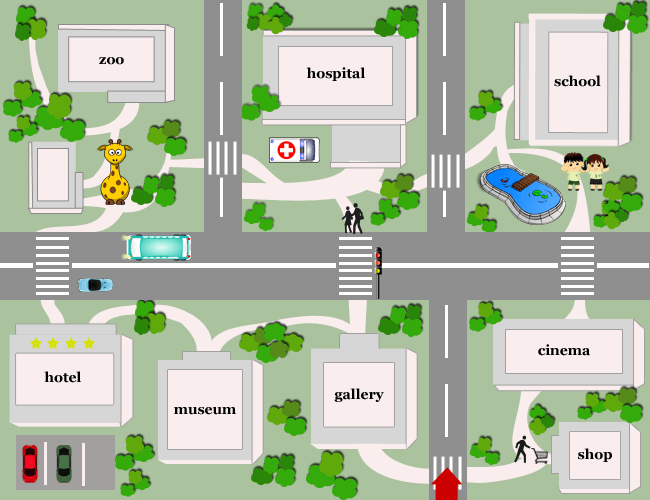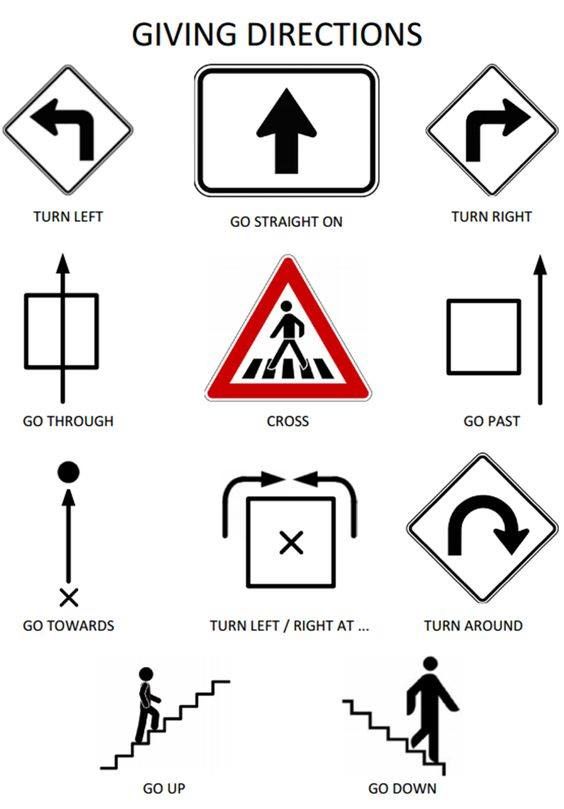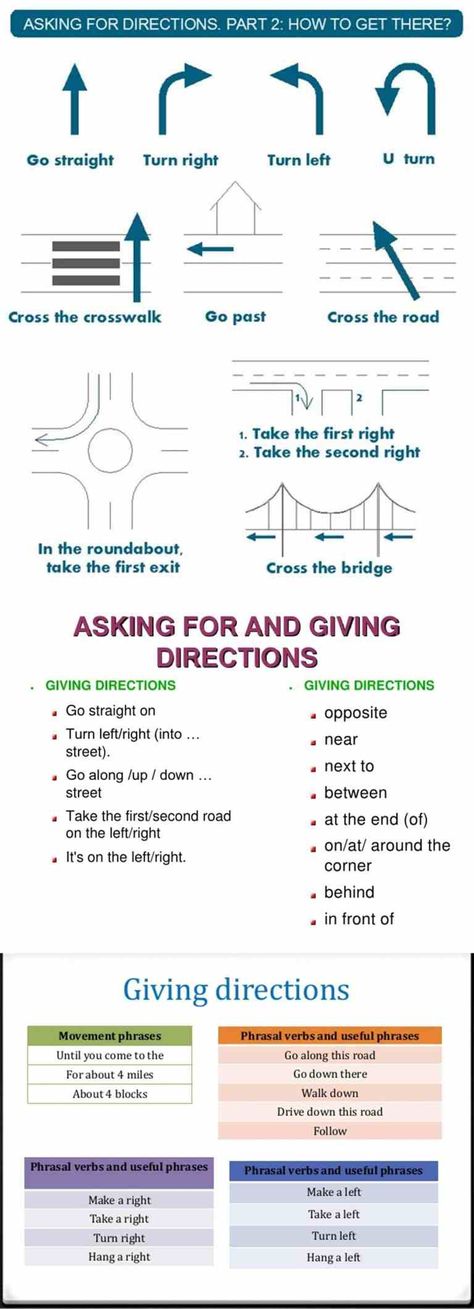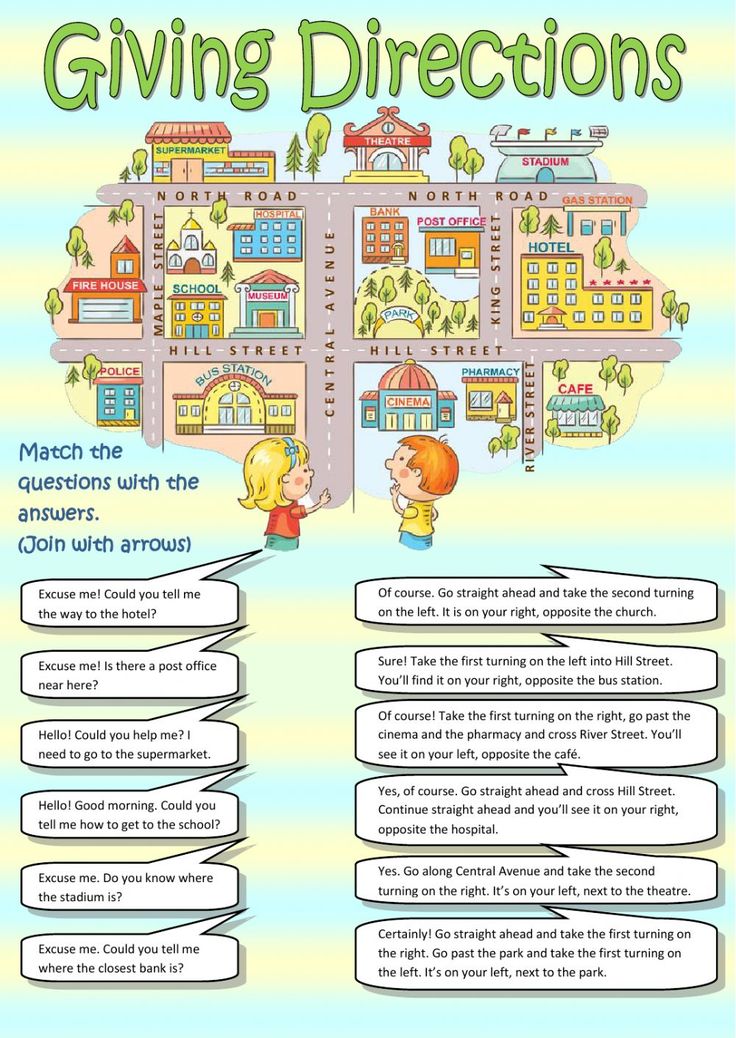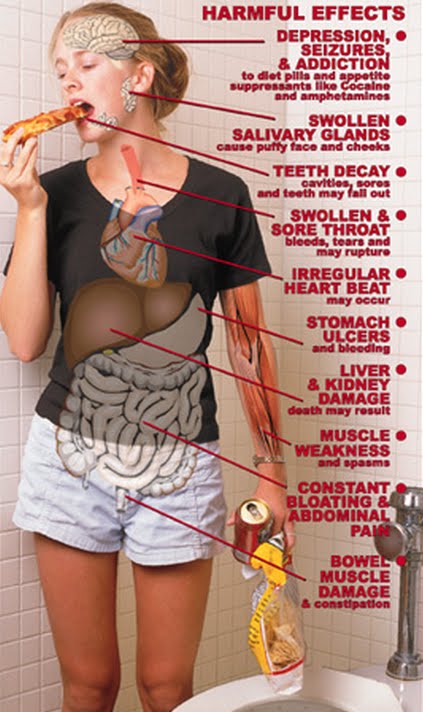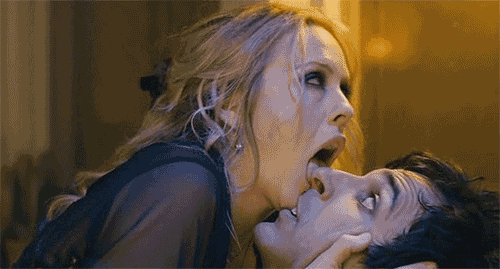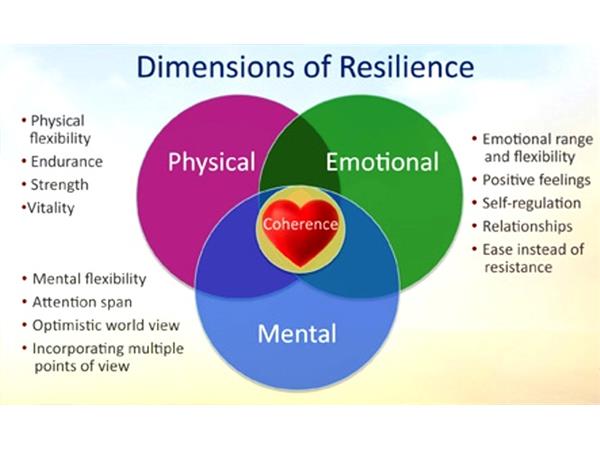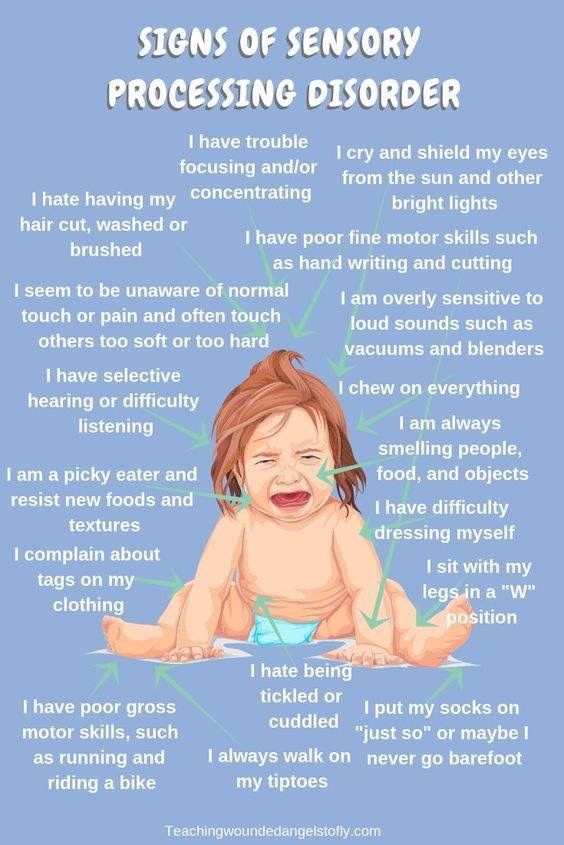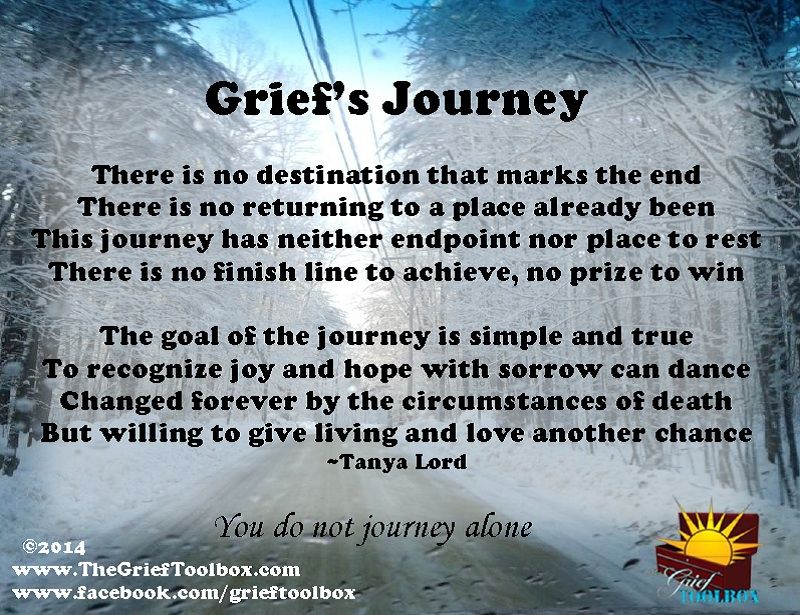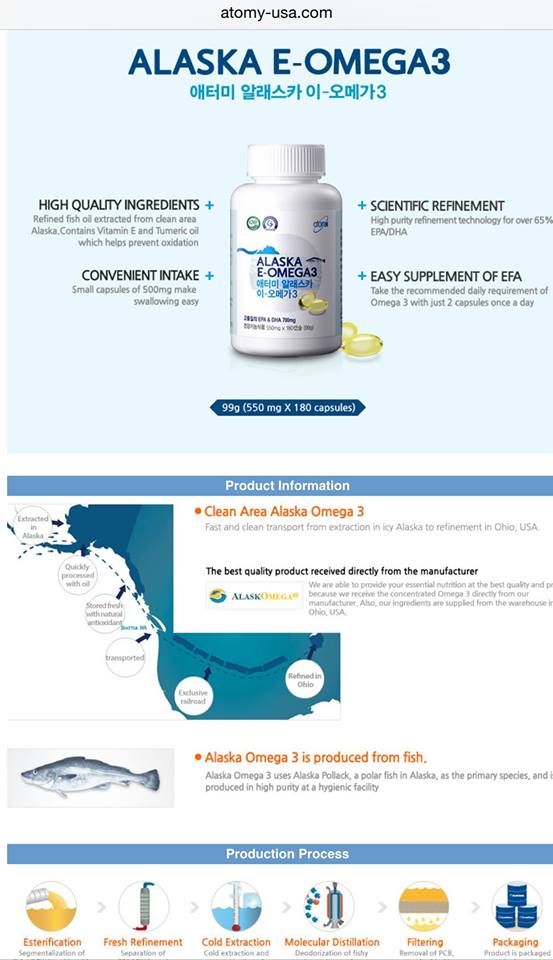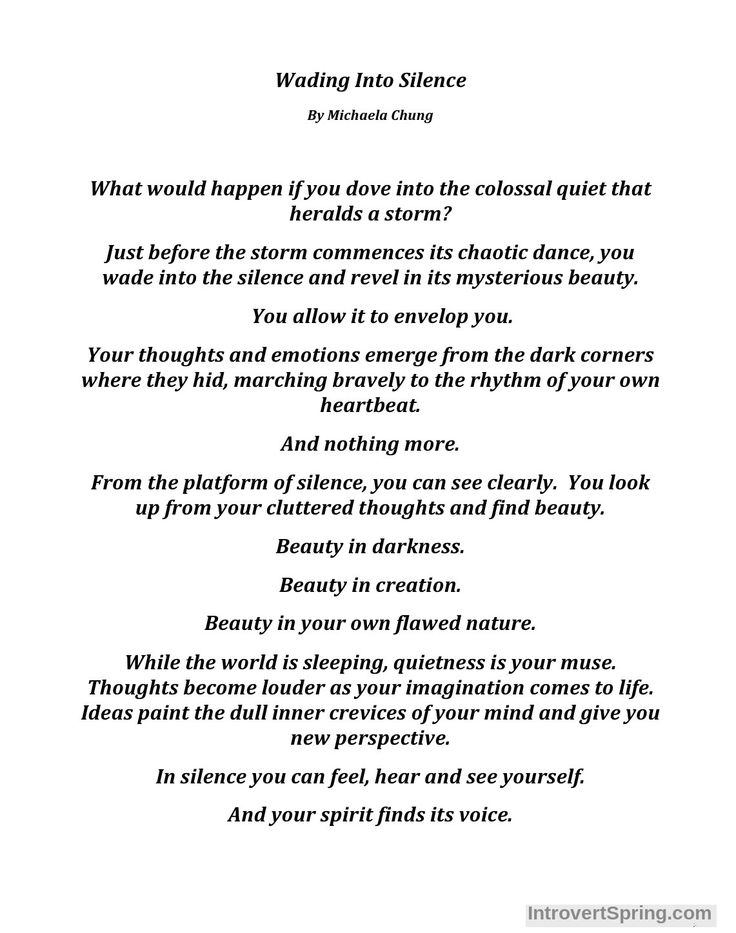Asking for direction
Asking and Giving Direction in English
ASKING FOR AND GIVING DIRECTIONS
Under this topic title, we will learn how to ask for directions and how to give directions to someone who asked us.
Before Asking For Directions:
Starting to conversation kindly is very good way. So, when we start talking, we can use the following forms:
Examples:
- Excuse me / Excuse me sir or madam.
- I am new here.
- I’m lost.
- I am sorry to interrupt you, but…
- Excuse me, could you help me, please?
- I am sorry.
- Sorry, I am not from around here.
- Excuse me madam, I seemed to be lost.
- Hello / Hello sir or madam.
Asking directions:
Sometimes we or someone need to find a place. And we need to ask someone else for help. When we’re asking for directions to someone, we use some phrases. These are given below;
Examples:
- Can you give me directions to the nearest hospital?
- Are we on the right road for London?
- How do you get to the bus stop?
- Where is the carnival?
- Where can I find the nearest car park?
- How do I get to library?
- Is there a pet shop near here?
- Where is the nearest post office?
- Do you know where the shopping center is?
- Is there a sports shop around here?
- Can you tell me how to get to train station from here?
- How can I get to the pub?
- What’s the best way to get to the amusement park from here?
- What’s the quickest way to get to the airport from here?
- What’s the easiest way to get to the nearest drugstore from here?
- Could you tell me where the nearest grocery store is?
- Where are you exactly?
- How do you get to the supermarket from here?
- I am looking for this address, am I in the right place / how can I get there?
- Can you tell me the way to the Nature Hotel?
- Is this the right way for the campground?
- Do you have a map?
- I am trying to find an exchange office.
Could you tell me how to get there?
- I am trying to get to the police station, Can you show me on the map?
- Could you help me, please? I’m looking for the bank.
- Does this bus go to the center?
- Do you know the cafe?
Answering the question:
1. If we don’t know the answer, we can say;
- I am sorry.
- I don’t know.
- I am stranger here myself.
2. If we or someone know the question, give the directions;
* Commonly used verbs for giving directions are colored below.
a. Giving Directions to Say ‘Go Straight’;
- Go straight.
- Go along the road.
- Go down there.
- Go down or walk down the street.
- Go up or walk up the street.
- Go straight along this road.
- Go past the bus stop.
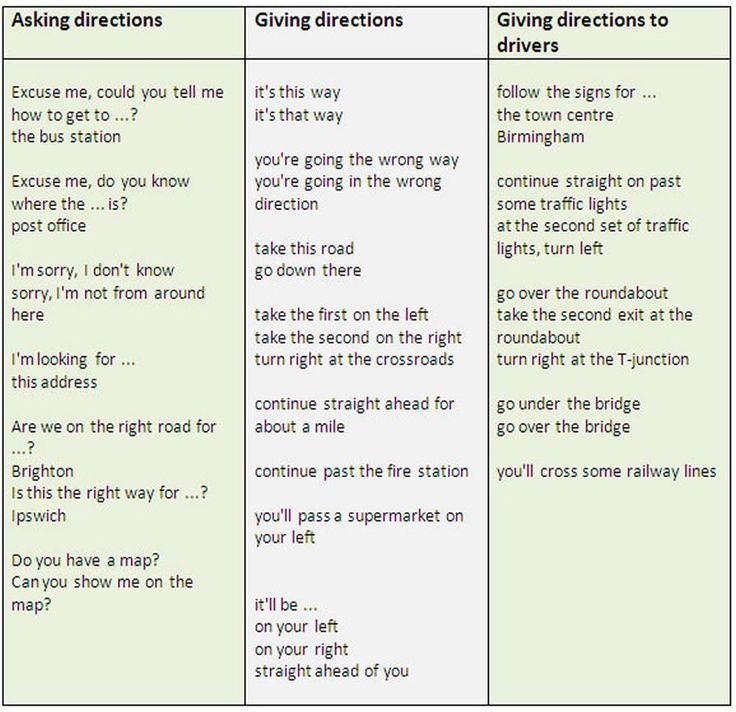
- Go toward the church.
- Go ahead.
- Go straight ahead
- Go ahead and ask someone.
- Go on ahead.
- Go straight on until you come to the crossroad.
- Go straight on left / right.
- Go straight at the lights / at the roundabout /at the junction.
- Continue straight ahead for about a mile.
- Continue past the petrol station. ( paas the station and continue)
- Continue straight on past two traffic lights.
- Continue straight ahead for about two kilometres.
- Keep going for another station.
- Keep going down this Street.
- Keep going for another shop hundred metres.
- Keep going straight ahead you will see it on the right.
- Keep on the straight road.
- Keep walking ahead.
- Take this road.
- Walk to the corner.
- Follow this street for 300 metres.
- Follow the road until you get to the bank.
b. Giving Directions to Say ‘Turn’;
- Turn right.
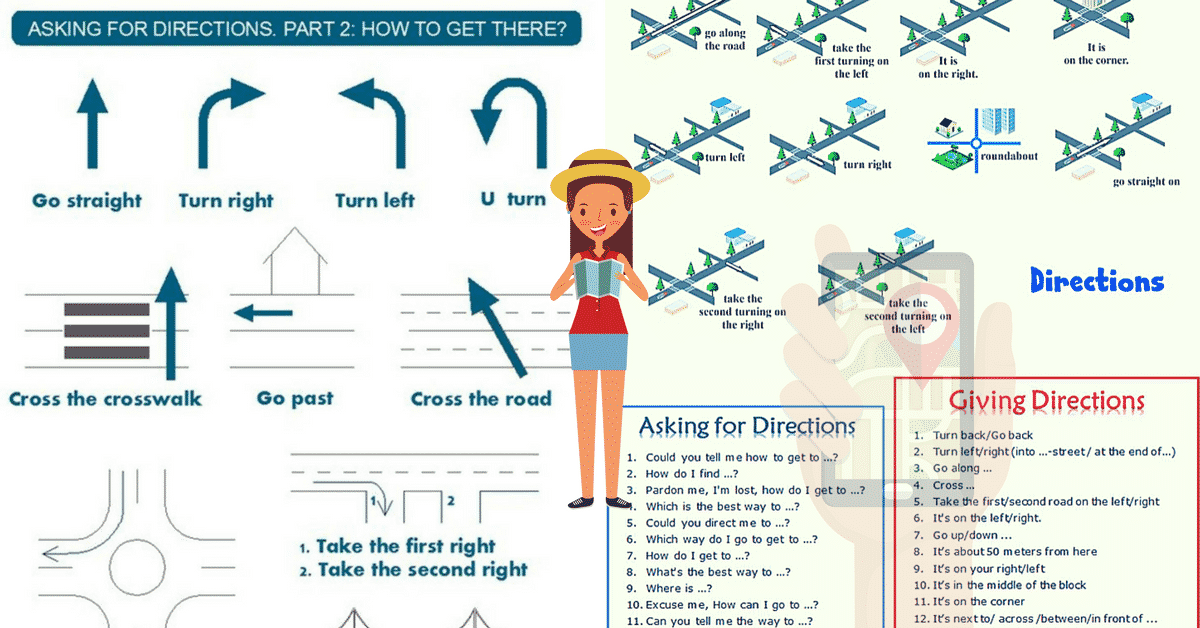
- Turn left.
- Turn left past the bank. ( pass the bank and then turn left )
- Turn back. ( go back)
- Turn left after the bridge.
- Turn right at the second turning ( turn left when you reach the turning )
- Turn right from the first alley.
- Turn left on to Daniel Street.
- Turn left at the end of the corridor.
- Turn right / left at the traffic lights / roundabout, etc.
- Turn right on after you pass the market on the right also.
- Turn left after you pass the bakery.
- Turn left past the phone shop.
- When you see a school on your right hand side, turn left in to European Street.
- Turn left after you pass the bakery.
- Go right / left at the end of the road.
- Take the first right”.
- Take the first / second / third street on the left / right.
- Take the first left when you enter Steven Road.
- You need to take a left / a right at the next traffic lights.
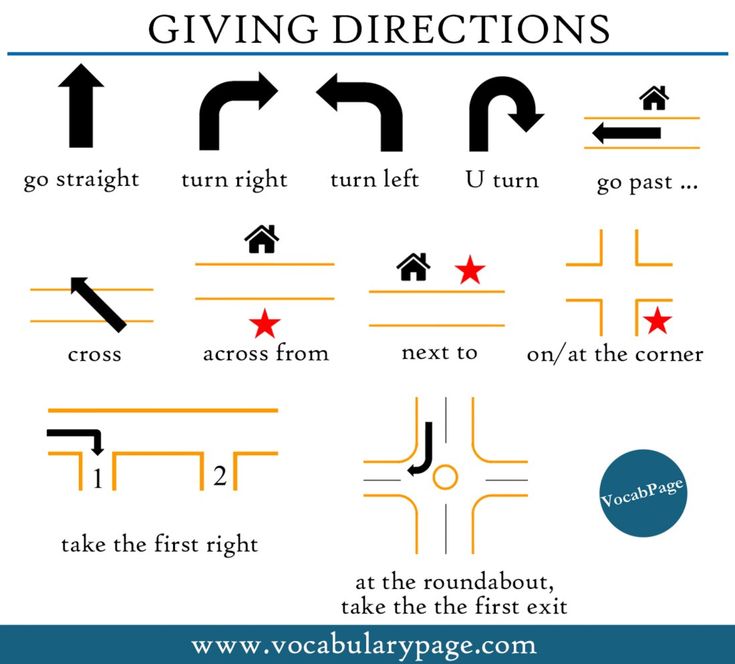
- Take a right / left at the junction.
- Take the second exit at the T- junction and then turn right at the traffic rights.
- When you get to Paris Street, take your next right.
- After you pass the restaurant on your left, take a right at the next crossroad.
- If you take the road on the left, you’ll come to the post office.
- Take a left when you come to the main street.
- Round the corner from the post office.
c. Giving Direcitons to Say ‘Cross’;
- Cross the pub.
- Pass the school.
- You will cross some traffic lights.
- Cross the taxi rank and you are there.
- Go over the bridge.
Giving locations:
* Commonly used prepositions for giving locations are colored below.
It is …
- on the left.
- on left.
- on the right.
- on right side.
- on the straight ahead.
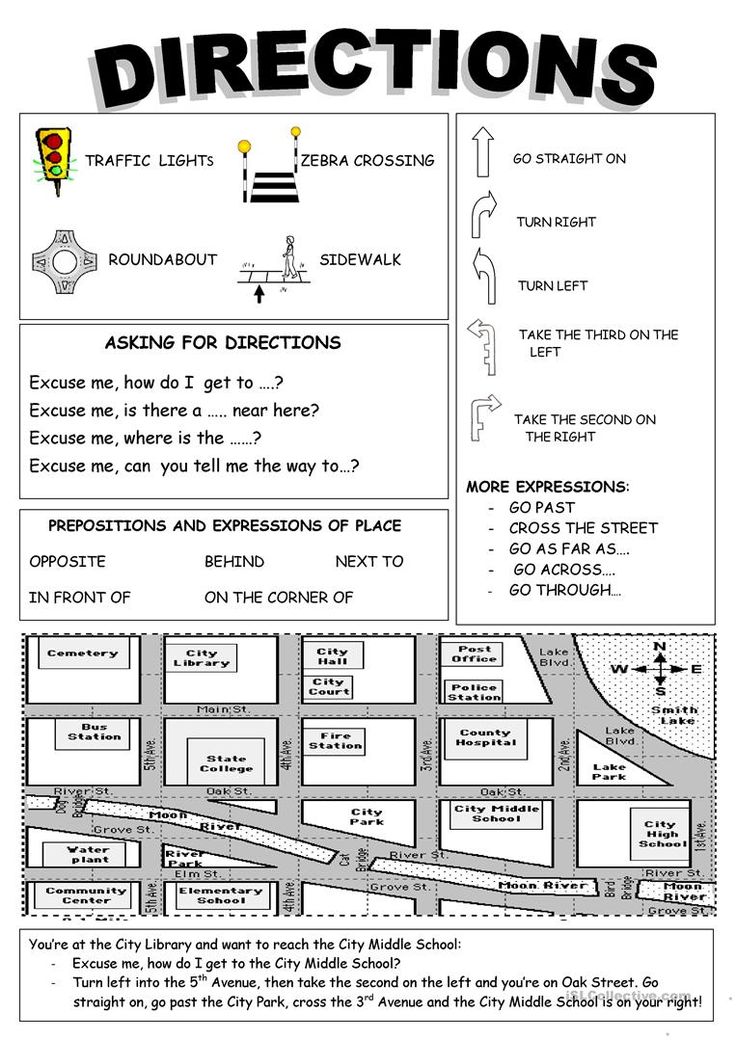
- on left after the gas station.
- straight ahead on the right.
- straight ahead of you.
- straight ahead on the left next to the book shop.
- opposite.
- opposite the bank.
- on opposite side of the Street.
- across the road.
- near my office.
- next to Mall.
- behind the hospital.
- in front of the bus station.
- between the our office and the supermarket.
- on the right in between the pet shop and the grocery store.
- at the end of Paris Street.
- on/at the corner of Daniel Road.
- over there, near the police station.
- just right / left around the corner.
- (just) around the corner.
- just around the corner on the left / right side.
- left around the corner next to the market.
- left around the corner from the subway.
- further down the road on the left.
- the biggest / smallest building on the left.
- in the centre of the town.
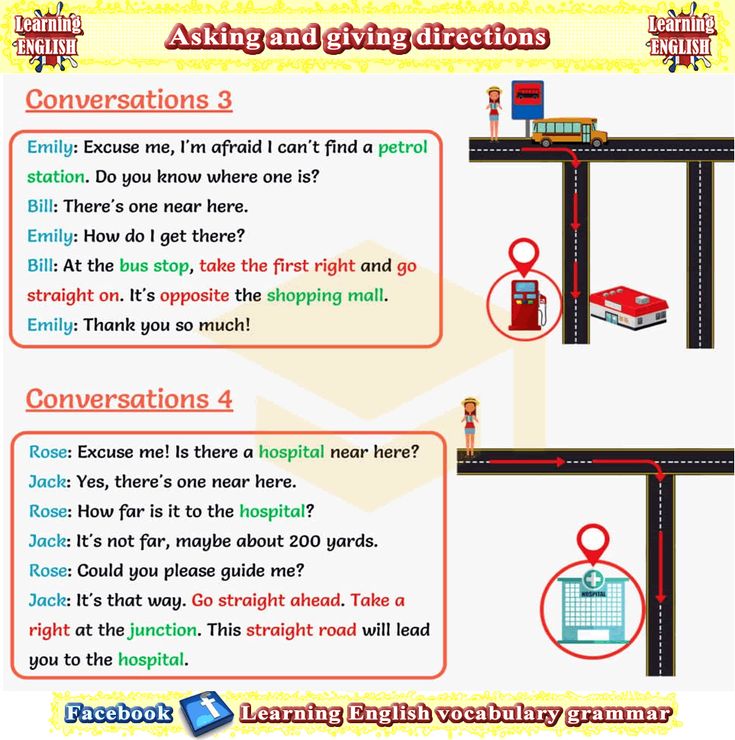
- the first turning on the right after the bank.
Other useful phrases for giving direction:
- It is this way / that way.
- You are going to wrong way.
- You are going in the wrong direction.
- You will pass a bakery on your left.
- It will be on your left or right.
- This straight road will lead you to the hospital.
- You will see the entrance on the left.
- You will pass a taxi rank on your left.
- Follow the sign for the town centre.
- You will see the car park infront of you.
- You can’t miss it.
- Come off the motorway / highway at the junction.
- The signpost said “London 18 miles” or “America”.
- Follow the signs to..
- You will come to a bus station.
- You will see the Black Lake.
Landmarks:
When giving directions we will often use landmarks help the other person understand where to find it.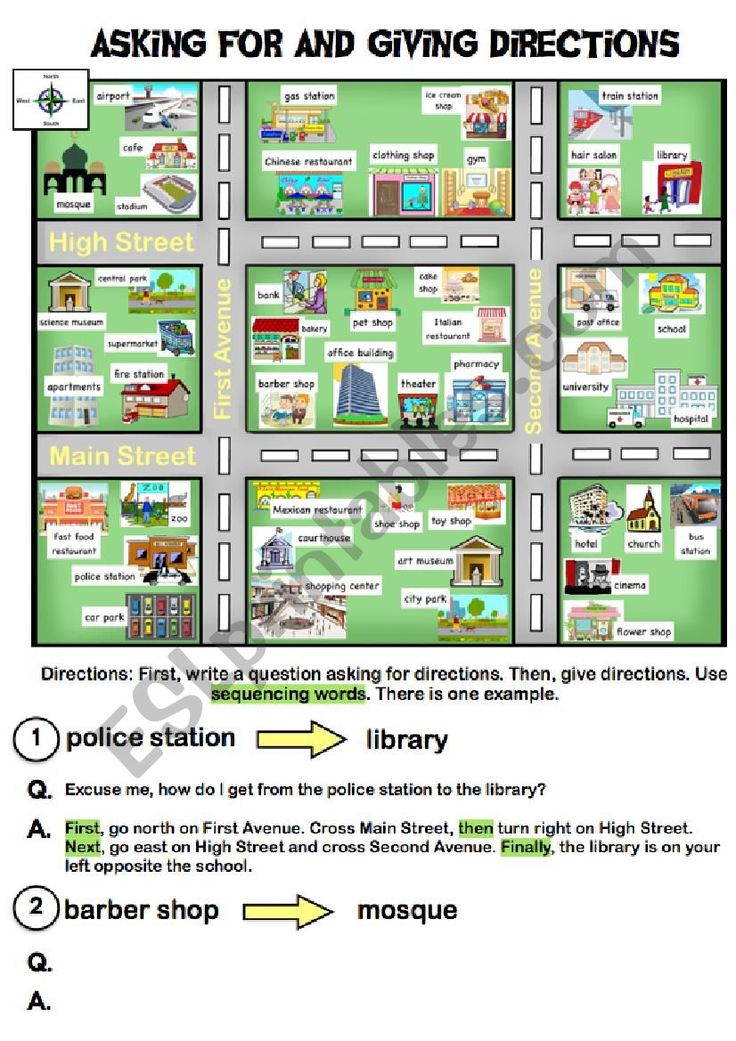
These are listed below; traffic lights, crossroads, junction, level crossing, signpost, T-junction, dead end, underpass, roundabout, flyover, motorway, bridge, railway bridge, railway line, dual carriageway, pedestrian crossing, zebra crossing, stop sign, hospital, police station, shopping centre, garage, petrol station, Airport, bus stop,station, Bookshop, Building and etc…
Asking for repetation:
- Sorry, I didn’t catch that.
- Could you say that again please?
- Could you repeat it again please?
- What did you say the street’s name was?
- Could you speak up please?
- Could you speak a little louder?
- Could you show me please?
Finishing Conversation:
- Thanks for help. Bye .
- Thank you for help. Good bye.
- Thank you for spending your time with me. Have a nice day!
The Best Ways to Give and Ask for Directions in English
Ever found yourself lost in a different country where your native language isn't necessarily the language spoken there? Maybe stuck at an airport in between two flights? Yes? Okay, great.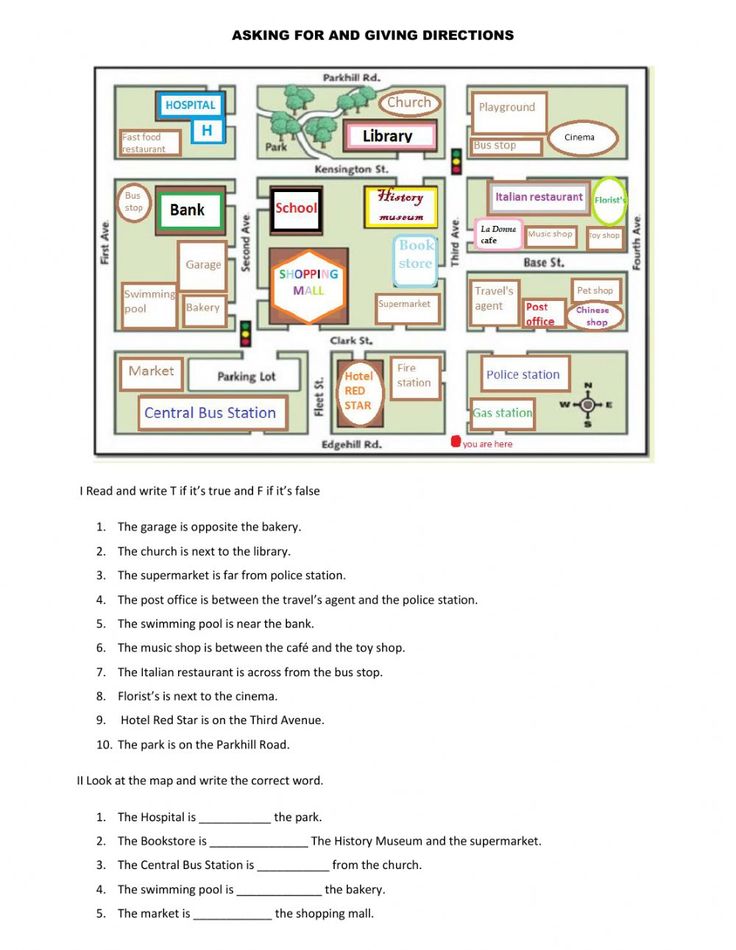
This article will provide you with the best words and phrases for giving and asking for directions in English regardless of where you go and the local language spoken there.
However, before going further into details, I'd like for us to first go over one essential, which all the other words and phrases simply cannot go without.
Excuse Yourself
When asking for directions, never underestimate the power of your first impression on other people. Different cultures have different customs, hence different ways of greeting people, especially in public places.
It is the defining moment before one gets directions that are actually true or gets some at all.
Therefore, when you're asking for directions, it is vital that you always approach a stranger with a simple "Excuse me" or "Sorry" before doing so. An immediate "Hello", "Hi" or "Can I ask you a question?" might exert different reactions and even push people away, depending on the context.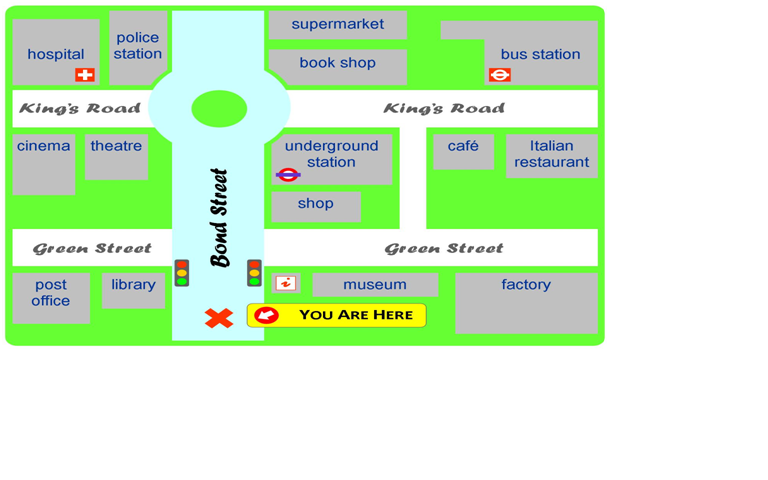
However, an "Excuse me" is simply the perfect introduction to whatever question or conversation you might have. Because English is such a widely spoken language, people will immediately understand that you are trying to converse in English and get themselves ready to help you.
Let's consider the following examples:
Hi. or Hello + main question
Can I ask you a question? + main question
While these expressions are pretty straight-forward and easy to utter, they might not exert the required reaction and might actually scare people away if you startle them, as explained above. How about adding "Excuse me" at the beginning of your conversation right before asking your desired question?
Excuse me. Hello. + main question
Sorry. Hi. Can I ask you a question? + main question
Excuse me. Hi. Can I ask you a question? + main question
Ah… suddenly, the air's a bit clearer. You not only sound pleasant, but people actually want to help you.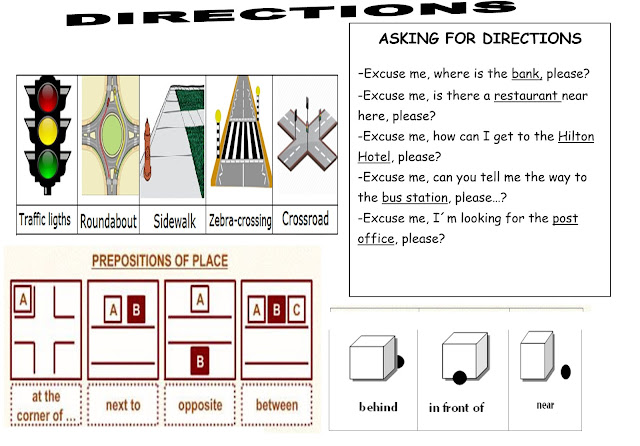
Other polite expressions and useful phrases you can throw in there are:
Sorry to bother you.
I'm (kind of) lost.
I'm struggling to find my way around this map.
The same goes for giving directions. Greet people with a simple "Hello" or "Hi" even if they don't do so in the first place.
Trust me, simple verbal gestures like this can be game-changers as far as getting your conversation with a stranger in a foreign city or country to the next level.
Once you've mastered the art of approaching someone the right way, the next step involves showing how well you can actually lead a conversation in English to either get or give the desired directions, regardless of whether it's in the street, at an airport or right next to your seat on the public transport.
Get Directions Quickly
If you want to ask for directions and get them, you have to be able to use the right expression, phrase or question at just the right time in order to make the person you’re approaching understand you and help you, at the very best.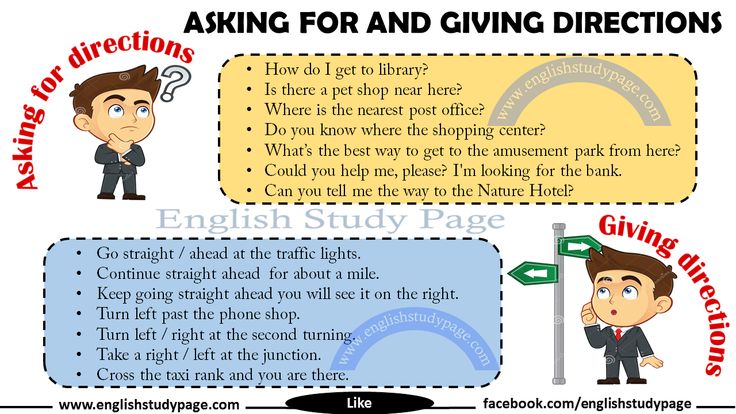
To do so, here are some extremely helpful utterances that more or less never fail to hit their mark.
Could you (please) tell me where ... is?
Could you tell me where the new Starbucks is?
I'm looking for... Could you (please) tell me where it is?
I'm looking for the Empire State Building. Could you please tell me where it is?
Could you (please) help me find…?
Could you help me find the Rotler's library on 6th Street?
Which way (leads) to...?
Which way to Madison Square Garden?
May I ask where ... is?
May I ask where Marienplatz is?
How do I get to...?
How do I get to the nearest metro station?
Note #1: In the sentences above, "could" can easily be replaced with "can" in each case. However, "could" is a tad bit more polite.
Note #2: Always remember to thank the person helping you by using any of the common English phrases used to show appreciation, such as "Thank you", "Thanks a lot", "Highly appreciate it", "God bless you", etc.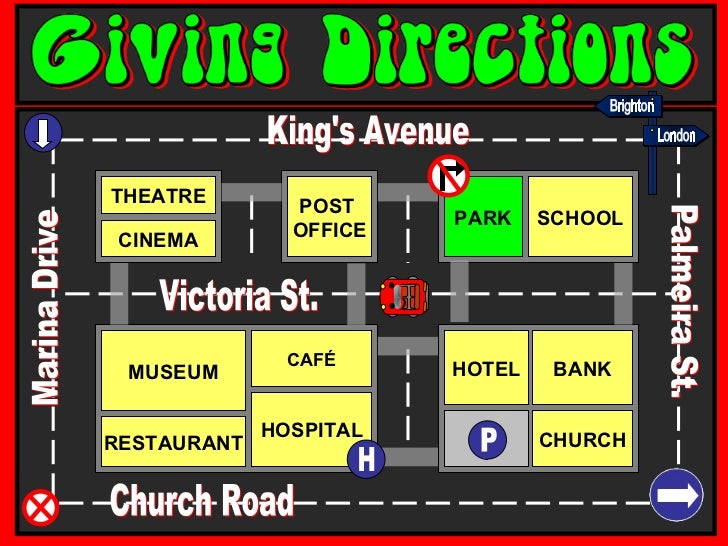
Moreover, it would be even better if you did some research beforehand about the most common greetings in that location to truly show your appreciation, regardless of what you say is in English or not.
Give Directions Cautiously
If you happen to get approached by someone in need of directions, it is your sacred duty to help them. Granted, you yourself might be a foreigner in a foreign country being approached by another foreigner in need of those directions, but isn't that what language is supposed to do - connect people?
Here are some great ways to always lend a helping hand and practice (or flaunt) your English in a conversation where you're the one giving the directions, not the other way around. I'll try to cover as many examples as possible, given the number of different situations one can find themselves in.
Go straight ahead on
Go straight ahead on Route 25 for 2 miles.
Go down
Go down Route 25 for 2 miles.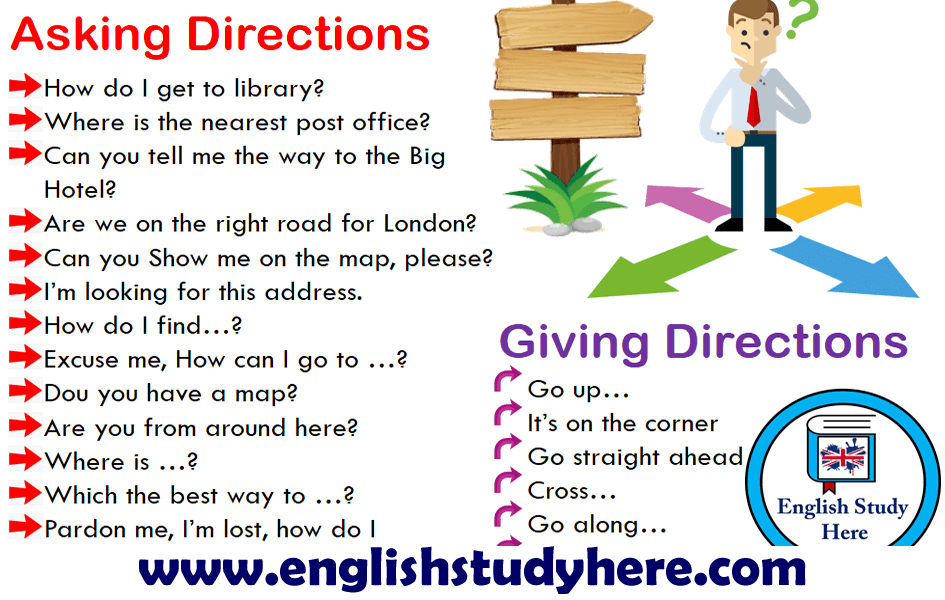
Go along
Go along Route 25 for 2 miles.
Follow
Follow Route 25 for 2 miles.
Note: The four examples above carry absolutely the same meaning in terms of directions. The verb "go" can also be easily replaced with e.g. "walk", "run", "proceed", "continue", etc. and many other vocabulary items, depending on the context.
Turn right/left
Turn right on 5th and Lurk.
Take a right/left turn
Take a right turn on 5th and Lurk.
Make a right/left turn
Make a right turn on 5th and Lurk.
Note: The three examples above carry absolutely the same meaning in terms of directions, as well. You can show even greater language skill by incorporating even more information in such a short expression, e.g. "take the first/second turn right/left" depending on the context.
Head to
Head to the Majestic Fountain and then turn right before the entrance.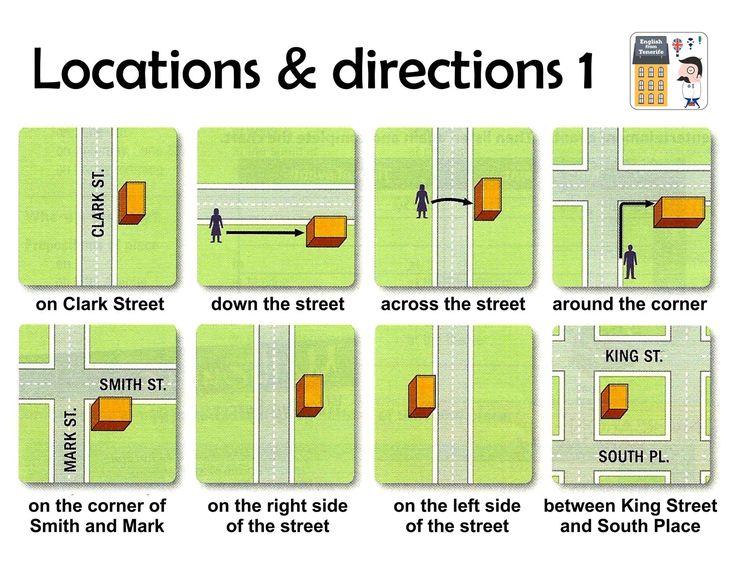
And many more…
Now, there are a few more conversational aspects to consider when giving directions to someone:
- Chronological order
Carefully provide correct but clear directions, regardless of how complicated they might seem. You can easily do that by putting the required steps in a somewhat chronological order through the usage of words such as: "First", "Second", "Then", "Once you get there", etc.
First, take the left turn right here. Then, go straight ahead on Road 25 for about 2 miles. You're supposed to reach a big roundabout. Once you get there, take the right exit and proceed...
- Spatial Prepositions
To better explain where a specific place or building is located in relation to something else, use prepositions, such as "over", "under", "around", "next to", "near", etc.
Go around the statue and proceed down the running lane.
Once you go under the bridge, there should be a bus station nearby.
- Advice and Suggestions
The easiest route might not always be the fastest one. You know it; I know it. Sometimes, bad traffic or construction work gets in the way of a great traveling experience. If you're aware of that, you should share. Still, try to make your English as clear as possible for any listener.
Going down Route 25 might seem shorter, but you're gonna wanna going to want to take a left turn to Route 26 and take the second exit on the first roundabout. That way, you can avoid any possible traffic. That road usually gets flooded very busy at this time of day. Trust me, I know what I'm talking about!
Oh... and no matter who you're talking to, don't use idioms or uncommon expressions to get your point across. Simple, plain English will suffice. You can still demonstrate your English knowledge and conversational skills without these pretty well.
Of course, that's as long as you don't make any pronunciation mistakes that are not necessarily native-like.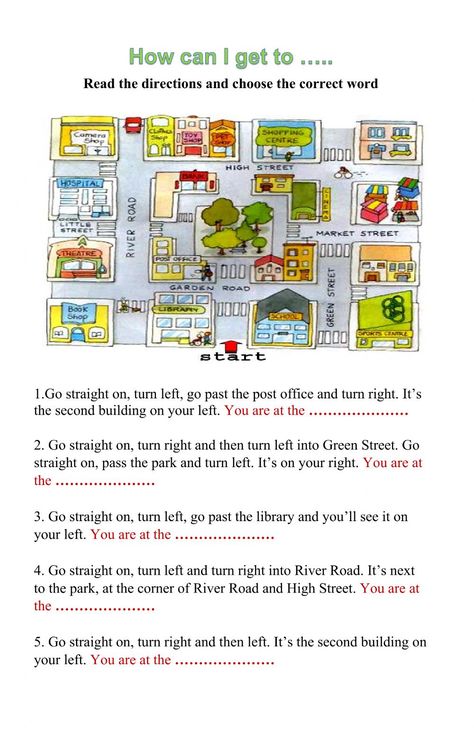
The Round-Up
Whether you're the one giving or asking for directions, it only matters that one doesn't get lost. Wherever you are in the world, the English language will almost never let you down.
A simple "Excuse me" can take you places. However, knowing what to say right after that is what always determines the next step on your journey, regardless of where and how you travel.
Use your English like a pro when you travel. Just try to remember today's tips on your next trip around the world to ensure you or anyone else traveling never misses a destination again.
Bon voyage!
| |
how to ask and give directions
How often in your life have you had to get lost on the streets of an unfamiliar city abroad? Or maybe you were asked how to get to such and such an address in English, but you did not know what to answer?
Let's fix this mistake once and for all and learn how to correctly ask for directions in English, and also learn how to give directions to other people in a difficult situation.
Read also: City objects and buildings in English
1312
I'm trying to get to the museum. - I'm trying to get to the museum (I need to find my way to the museum).
Do you know where the post office is? — Do you know where the post office is?
What’s the best way to get to the train station? — What is the best way to get to the railway station?
Can you give me directions to the nearest bus stop? - Can you give directions to the nearest bus stop?
How do I get to the train station? - How to get to the railway station?
Where can I find the nearest bakery? - Where can I find the nearest bakery?
How can I get to the bank? — How to get to the bank?
Where is the hospital? - Where is the hospital?
Can you show me on the map? — Can you show me on the map?
Remember to be polite:
Could you help me, please? I'm looking for the bank .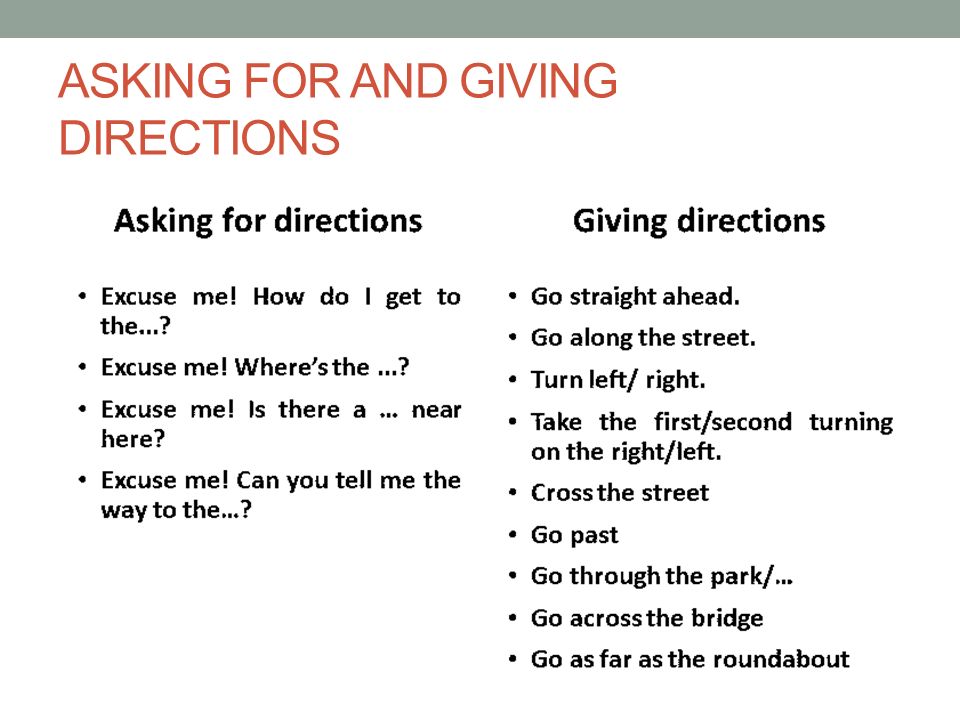 - Could you help me? I am looking for a bank.
- Could you help me? I am looking for a bank.
Pardon me! I'm lost. Could you tell me how to get to the bookstore? - Sorry! I'm lost. Could you tell me how to find a bookstore?
Exuse me, how can I go to the library? — Excuse me, how can I get to the library?
Exuse me, is there a supermarket near here? — Excuse me, is there a supermarket anywhere nearby?
Pardon me, I'm lost, how do I get to the library? - Sorry, I'm lost, how do I get to the library?
Could you, please, tell me how to get to the computer store? - Could you tell me how to get to the computer store?
Specify directions in English
The picture shows the main directions of movement with translation:
And here is a list of useful phrases that will help you show the way in any situation.
Where is it
It’s opposite the church. - It's opposite the church.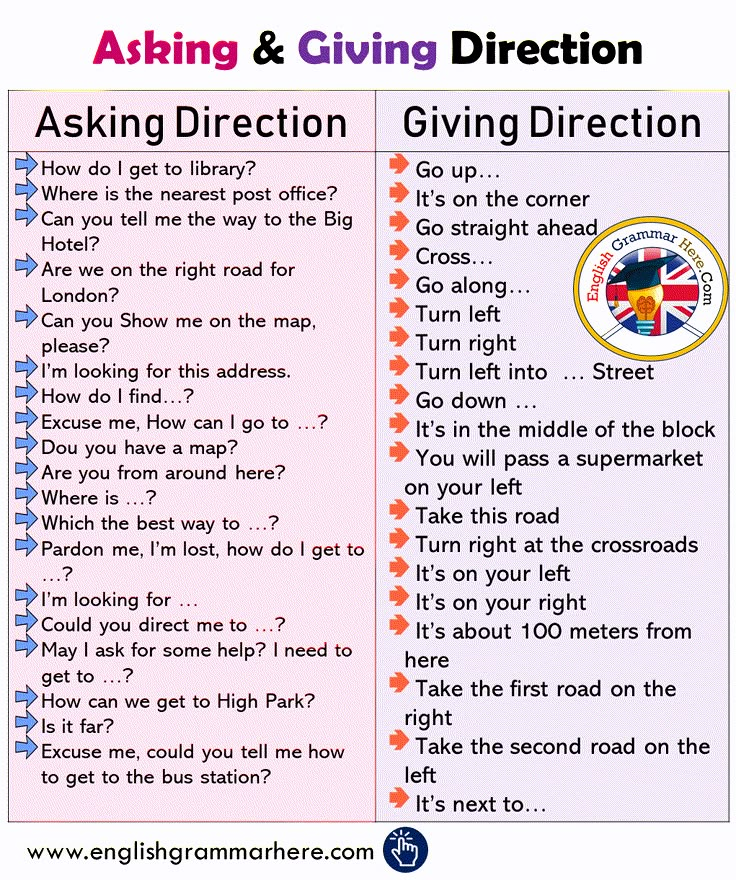
It is behind the hospital. - It's behind the hospital.
It is in front of the bus station. - This is in front of the bus station.
It's next to the bank. - It's next to the bank.
It's between the school and the shop. - This is between the school and the store.
It's at the end of the road. - It's at the end of the road.
It is in the center of the town. - This is in the center (of the city).
It's on the corner of Market Street and Baker Street. - It's on the corner of Market Street and Baker Street.
It's just behind this building. - It's behind this building.
It's in front of the school. - This is in front of the school.
It's just around the corner. - It's around the corner.
It's on the left/right.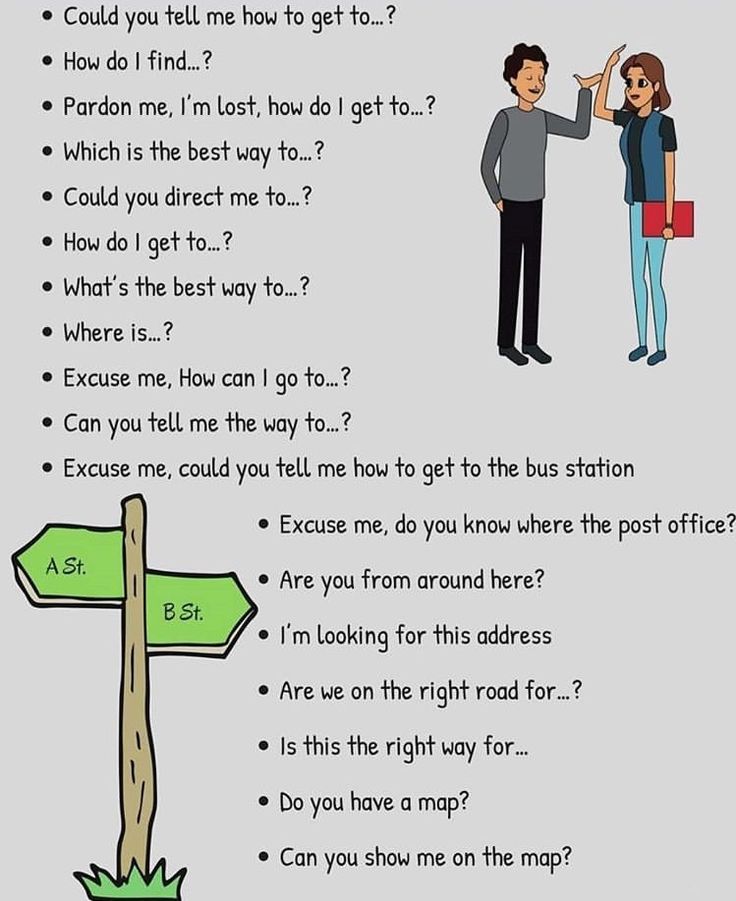 - This is (located) on the left / right.
- This is (located) on the left / right.
It's around the corner. - It's around the corner.
It is better if you take a taxi. - It's better to take a taxi.
It's 500 meters from here. - It's 500 meters from here.
Bank Street is parallel with this street . — Bank Street is parallel to this street.
Penny Street is perpendicular to this street. - Penny Street is perpendicular to this street.
It's four blocks down the street on this side of the road. - It's four blocks down this side of the street.
Where to go
It’s this way. - Over here.
It's that way. - There.
You're going the wrong way. - You are going the wrong way (wrong).
You're going in the wrong direction . “You are moving in the wrong direction.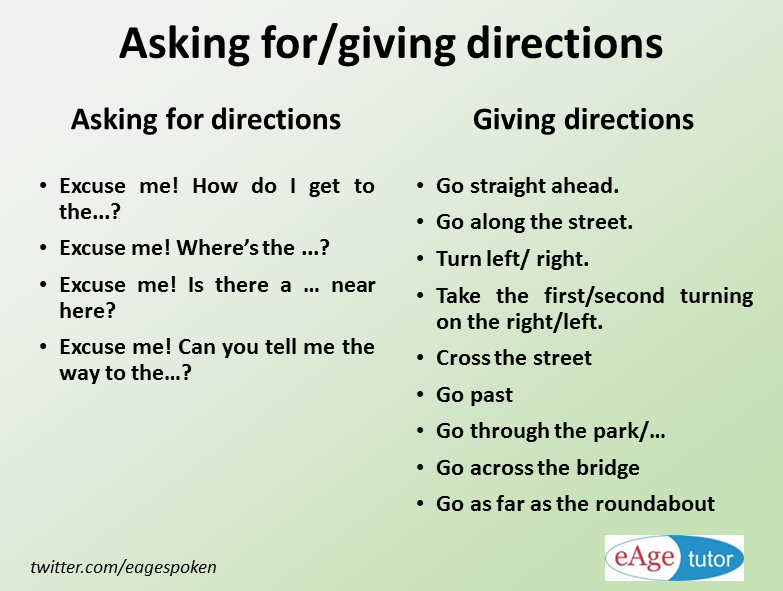
Take the first left. - First left turn.
Take the second right. - Second turn to the right.
Turn right at the crossroads. - Turn right at the crossroads.
Go along the street until you reach the traffic lights. - Walk down the street to the traffic lights.
Go straight on until you come to a crossroads. - Go straight to the crossroads.
Turn left into Gordon Street . - Turn left onto Gordon Street.
Go past the cinema. (Pass the cinema.) - Pass the cinema.
Take the next left. - Next turn - left.
Turn right at the traffic lights. - Turn right at the traffic lights.
Turn right at the round about . - Turn right at the roundabout.
Read also: Prepositions of direction in English
Dialogue on the topic
If the presented material seems insufficient to you, I suggest moving on to a dialogue on the topic of orientation in English.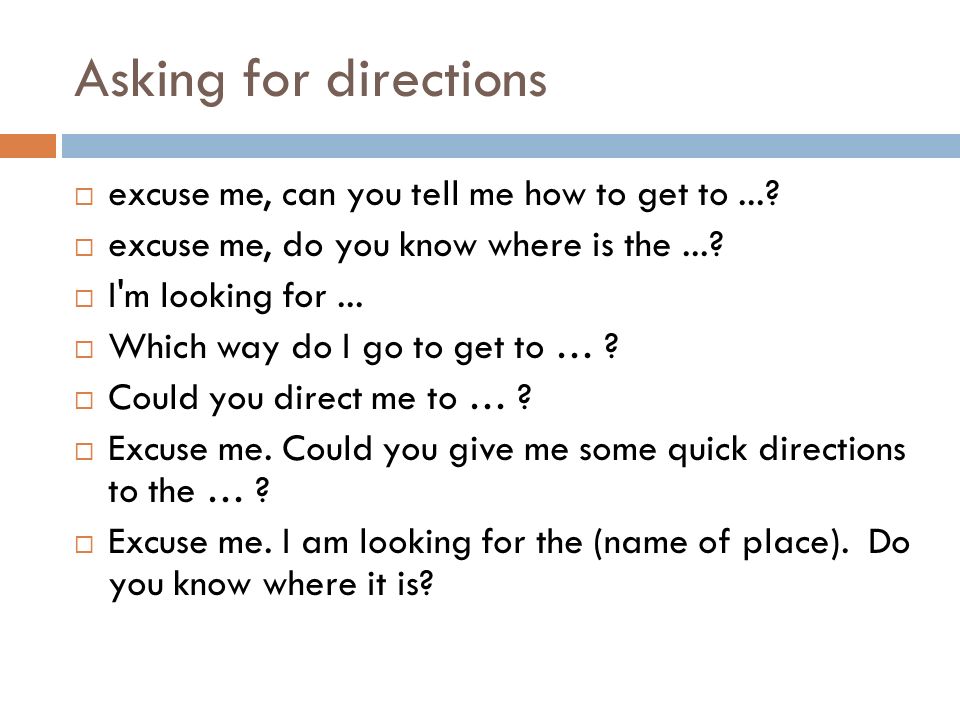 Here you will find many additional phrases about how to ask for directions or help someone by indicating the direction of travel.
Here you will find many additional phrases about how to ask for directions or help someone by indicating the direction of travel.
Fill in the gaps in the sentences with the following words: east, bank, school, roundabout, third, church.
The dialogue is quite interesting and simple, so try to translate it yourself. Moreover, you received enough hints in this lesson, so you can use them when translating.
Lenny : Excuse me, I'm trying to find a pub called the Cock & Bull. Could you point me in the right direction?
George : Ah… the Cock & Bull. I know it well. excellent pub.
Lenny : Oh, great. I'm new to the city and I'm supposed to meet a friend there, but I haven't got a clue where I am.
George : Right. Go straight ahead. Then, take the (1) _______ road on your left. That's Queen Street. Follow it until you pass a (2) ________, and then… No, hang on. That's not right.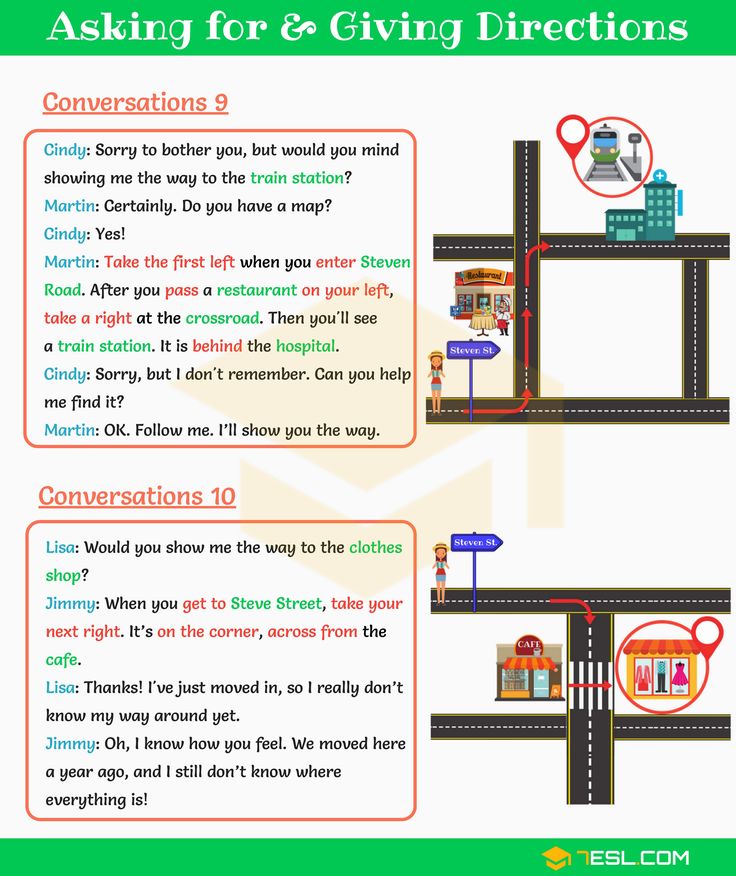
Lenny : Oh, I can ask someone else if you're not sure.
George : No, no. I know London like the back of my hand… OK. Ignore everything I just said. From here, you want to get onto Charles Street, which is parallel to this street. Then walk (3) ______ about 500 meters until you see an old (4) _______. Turn right at the church and… Wait a minute…
Lenny : I’ve got a map here…
George : I don’t need a map. I've lived here all my life. And the Cock & Bull isn't far. Excellent pub, by the way. They do a fantastic steak and kidney pie… Or was it steak and mushroom? Anyway. Go about four hundred meters that way and when you get to a (5)____________, hang a left. Walk for another two minutes and you'll see a (5)_________ on the opposite side of the road. The pub is just next to the bank. You can't miss it.
Lenny : Great! thank you!
George : No, hold on… That's where the pub used to be.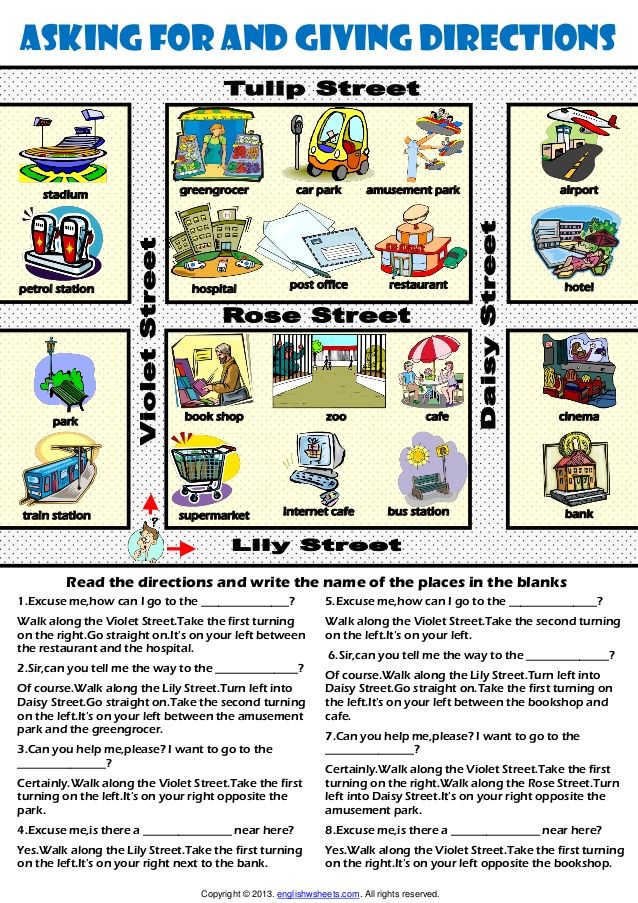
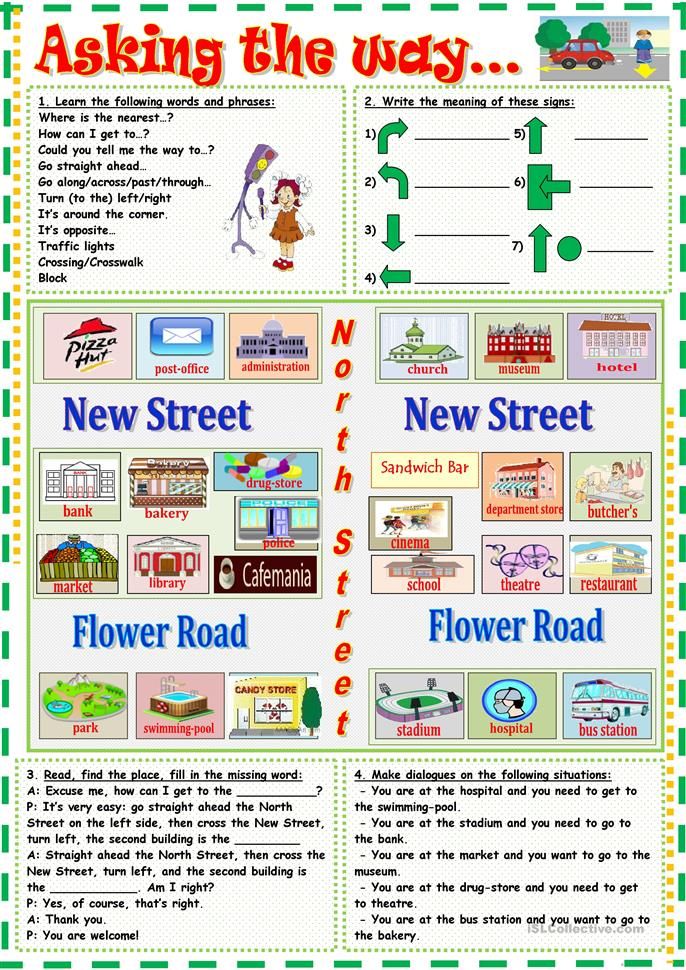 ..
.. 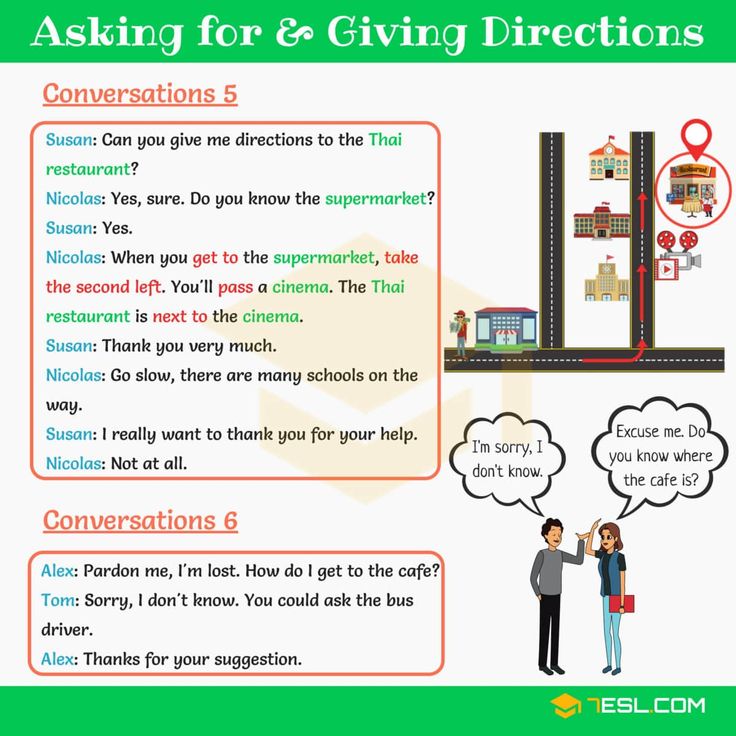 .. .
.. . 